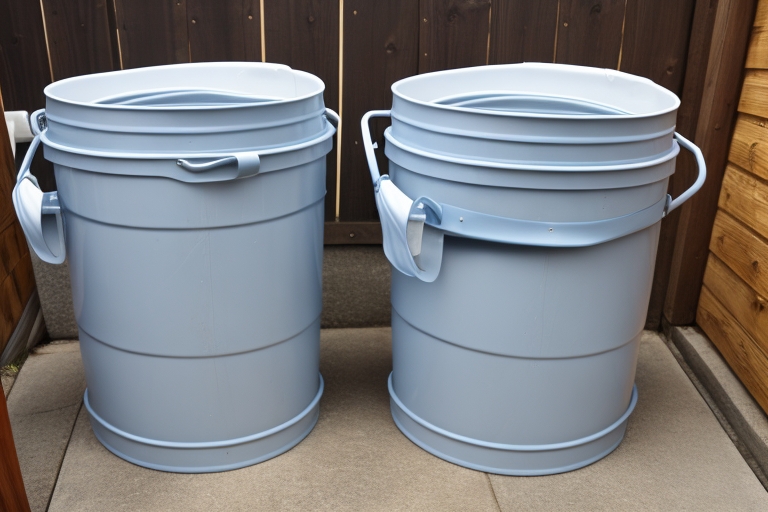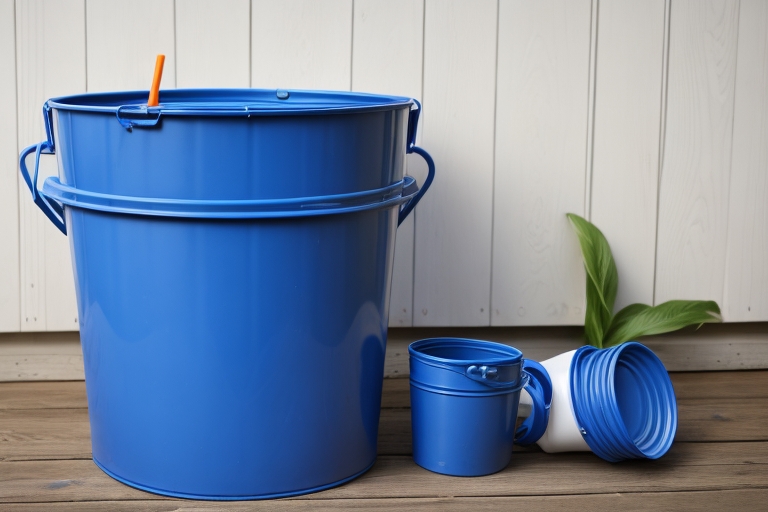
It depends on your priorities and the specific requirements of your food storage. Mylar bags offer a robust solution for long-term food storage in 5-gallon buckets, providing a multi-layered barrier against oxygen, moisture, and pests. If you’re aiming for extended shelf life and comprehensive protection, Mylar bags are a solid choice.
However, they might not be absolutely necessary in every situation. Here are some considerations:
- Short-Term Storage: If you’re storing food for a relatively short period, such as a few months, and you have a climate-controlled environment, you might get away without using Mylar bags. Vacuum sealing or using oxygen absorbers could be sufficient for shorter durations.
- Cost Constraints: Mylar bags, along with 5-gallon buckets, can incur additional costs. If you’re on a tight budget, alternatives like vacuum sealing or oxygen absorbers might be more financially feasible.
- Type of Food: Certain foods are more sensitive to environmental factors. If you’re storing items prone to rapid deterioration, like certain grains or dehydrated fruits, the added protection of Mylar bags becomes more beneficial.
- Pest Concerns: If you live in an area with a high risk of pest infestation, Mylar bags provide an extra layer of defense against insects and rodents. If pests are not a significant concern, other methods might suffice.
While Mylar bags offer a robust solution for comprehensive food storage, they might not be an absolute necessity in every scenario. It’s a matter of weighing factors like storage duration, the type of food, environmental conditions, and budget constraints to determine the most suitable method for your specific needs.
What are Mylar bags?
Mylar bags are a type of flexible packaging made from a polyester film called BoPET (biaxially-oriented polyethylene terephthalate). They’re known for their high tensile strength, durability, and excellent barrier properties.
The primary purpose of Mylar bags in food storage is to create a protective barrier against external elements like oxygen, moisture, and pests. These bags are commonly used for long-term storage of food items such as grains, dried fruits, and dehydrated meals.
Here’s how Mylar bags work to safeguard food:
- Oxygen Barrier: Mylar has a very low oxygen transmission rate, meaning it minimizes the passage of oxygen through the material. Oxygen is a major contributor to food spoilage, as it can lead to oxidation and the growth of aerobic bacteria. By using Mylar bags, the exposure of food to oxygen is significantly reduced, helping to extend its shelf life.
- Moisture Resistance: Mylar is also effective at blocking moisture, preventing it from reaching the stored food. Moisture can promote the growth of mold, yeast, and bacteria, leading to the degradation of food quality. Mylar bags act as a moisture barrier, keeping the contents dry and preserving their texture and flavor.
- Pest Protection: Mylar bags are generally sealed airtight, providing a barrier that helps keep pests such as insects and rodents away from the stored food. This is crucial for preventing contamination and maintaining the integrity of the stored items.
Mylar bags play a vital role in maintaining the quality and edibility of stored food by creating a protective environment that limits exposure to oxygen, moisture, and pests.
Benefits of using Mylar bags in food storage
Using Mylar bags in conjunction with 5-gallon buckets offers several benefits for food storage:
- Extended Shelf Life: One of the primary advantages is the extended shelf life of the stored food. The combination of Mylar bags and 5-gallon buckets creates a double barrier against oxygen and moisture, significantly slowing down the deterioration of food. This is particularly important for long-term storage of items like grains, rice, and legumes.
- Airtight Seal: When Mylar bags are properly sealed within 5-gallon buckets, it creates an airtight environment. This hermetic seal prevents the entry of oxygen, which is crucial for inhibiting the growth of aerobic bacteria and fungi. It also helps preserve the nutritional value and flavor of the stored food.
- Protection Against Pests: The use of 5-gallon buckets adds an extra layer of protection against pests. Even if pests manage to breach the Mylar bag, the bucket acts as a physical barrier, making it more difficult for insects or rodents to access the food inside.
- Durability and Strength: Mylar bags, when placed inside sturdy 5-gallon buckets, are less prone to damage from external factors. The buckets provide additional protection against punctures, tears, or other physical damage, ensuring the integrity of the food storage system.
- Easy Handling and Organization: 5-gallon buckets are convenient for handling and organizing stored items. They are stackable, making efficient use of space, and the rigid structure helps prevent crushing of the Mylar bags. This makes it easier to manage and access your food storage supply.
- Versatility: Mylar bags and 5-gallon buckets are versatile and suitable for storing a wide range of food items, from grains and pasta to dehydrated fruits and vegetables. The combination allows for flexibility in organizing different types of food in a single storage system.
- Cost-Effective: Compared to some alternative storage methods, using Mylar bags and 5-gallon buckets can be cost-effective. These materials are relatively affordable and widely available, making them a practical choice for individuals and families looking to build a long-term food storage supply.
In summary, the use of Mylar bags in conjunction with 5-gallon buckets offers a comprehensive and effective solution for food storage, providing extended shelf life, protection against external elements, and ease of handling and organization.
Alternatives to Mylar bags

There are alternative methods for food storage in 5-gallon buckets, each with its own set of advantages and considerations. Let’s explore two common alternatives: vacuum sealing and using oxygen absorbers.
- Vacuum Sealing:
- How it works: Vacuum sealing involves removing the air from a plastic bag and sealing it to create a vacuum-packed environment. This process aims to eliminate oxygen, which helps slow down the oxidation and deterioration of food.
- Advantages:
- Effective in reducing oxygen exposure.
- Preserves the texture, flavor, and nutritional value of the stored food.
- Allows for efficient use of space, as vacuum-sealed bags can conform to the shape of the food.
- Considerations:
- May not be as durable as Mylar bags, making them more susceptible to punctures and tears.
- Limited protection against light and pests compared to Mylar bags.
- More suitable for short to medium-term storage.
- Oxygen Absorbers:
- How it works: Oxygen absorbers are small packets containing iron powder that absorbs oxygen when exposed to air. Placing these absorbers in a sealed container helps create an oxygen-free environment.
- Advantages:
- Simple and cost-effective method to reduce oxygen levels.
- Can be used with various types of containers, including 5-gallon buckets.
- Easy to use and widely available.
- Considerations:
- Does not provide a physical barrier against moisture or pests.
- Effectiveness depends on the size of the container and the type of food being stored.
- Suitable for short to medium-term storage and works best in a sealed, airtight environment.
Comparison with Mylar Bags:
- Oxygen Protection: Mylar bags provide a superior barrier against oxygen compared to vacuum sealing and oxygen absorbers. The thickness and composition of Mylar offer a more reliable defense against the permeation of oxygen.
- Moisture and Pest Protection: Mylar bags, when properly sealed, offer better protection against moisture and pests due to their airtight seal and durable material. Vacuum-sealed bags may not provide the same level of protection.
- Durability: Mylar bags are generally more durable and resistant to punctures and tears compared to vacuum-sealed bags.
- Long-Term Storage: Mylar bags are often preferred for long-term storage due to their comprehensive protective qualities.
While vacuum sealing and oxygen absorbers can be effective for certain storage needs, Mylar bags remain a more comprehensive and durable solution, especially for extended periods of food storage in 5-gallon buckets. Each method has its place, and the choice depends on factors such as storage duration, type of food, and desired level of protection.
FAQs regarding the use of Mylar bags for food storage in 5-gallon buckets:
- What is a Mylar bag, and why is it used in food storage?
- Answer: A Mylar bag is a type of flexible, durable, and heat-resistant material often used in food storage. It acts as an additional layer to protect food from external elements, such as light, moisture, and oxygen, thereby extending shelf life.
- Are Mylar bags necessary for storing food in 5-gallon buckets?
- Answer: Yes, Mylar bags are often recommended for use in conjunction with 5-gallon buckets for long-term food storage. They create an additional barrier against moisture and oxygen, helping to preserve the quality and freshness of stored food over an extended period.
- What benefits do Mylar bags provide in food storage?
- Answer: Mylar bags offer several benefits, including:
- Protection against light, which can degrade the quality of some foods.
- Resistance to moisture, preventing the growth of mold and bacteria.
- A barrier to oxygen, which helps prevent oxidation and spoilage of food.
- Enhanced durability and puncture resistance, ensuring the integrity of the stored items.
- Answer: Mylar bags offer several benefits, including:
- Can I use 5-gallon buckets without Mylar bags for food storage?
- Answer: While 5-gallon buckets provide a convenient and sturdy container for food storage, using Mylar bags inside them is recommended for long-term storage. Mylar adds an extra layer of protection that helps maintain the quality and nutritional value of the stored food.
- How do I use Mylar bags in conjunction with 5-gallon buckets for food storage?
- Answer: To use Mylar bags with 5-gallon buckets:
- Place the Mylar bag inside the bucket.
- Fill the Mylar bag with the desired food items.
- Remove excess air and seal the Mylar bag.
- Place a lid on the 5-gallon bucket, ensuring a tight seal.
- Store the sealed bucket in a cool, dry place away from direct sunlight.
- Answer: To use Mylar bags with 5-gallon buckets:

Pingback: What Is a Food Grade Bucket?
Pingback: Why Do We Use A Bottling Bucket?